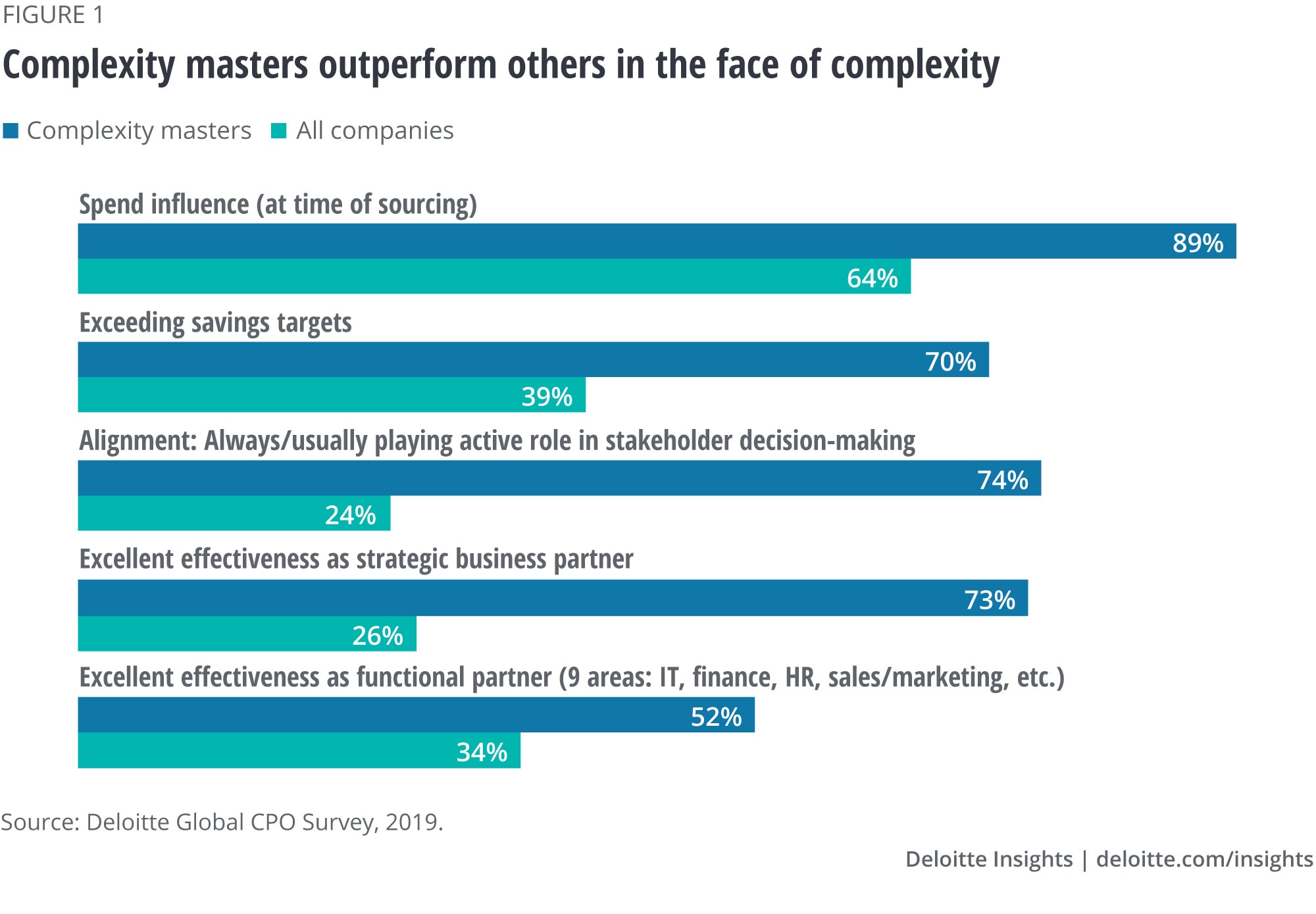
The good, the bad, and the digital Mastering digital transformation to untangle procurement complexity
3 minute read
22 October 2019
No longer simply a buzzword, digital transformation is becoming an imperative for top-performing procurement organizations. If CPOs are able to transform their organizations and fundamentally shift the way they operate, they will be able to achieve mastery over all other forms of complexity.
If there were one word to describe the scenario chief procurement officers (CPOs) are facing in 2019, it would be complexity. Procurement organizations today shoulder an expansive and intricate set of responsibilities, and each new task that arises from these responsibilities adds another node to an ever-growing network of complex initiatives and challenges to address.
Some of these are ever-present, such as the perennial concerns about cost reduction. Others are reactions to new problems, such as the high levels of risk and uncertainty prevalent in the current business environment. Findings of our survey1 indicate that over 60 percent of firms have seen increases in procurement-related risk in the last 12 months. Norms of global trade are being challenged through changing pacts and levies, and this is certainly evidenced in the supply chain (see sidebar, “A change in focus and approach for businesses”).
A change in focus and approach for businesses
According to the survey findings, the top risk scenarios for manufacturers today include economic downturn/deflation (56 percent), followed by trade war (48 percent), Brexit uncertainty (31 percent), and China slowdown (27 percent).
Global value chains are being fundamentally restructured—there is now a gradual shift away from heavily globalized supply chains toward more domestic, regionally focused supply chains. The topic is front-and-center with CEOs on their earnings calls, and is also being acknowledged by CPOs. Our survey findings reveal that the top two “strong priority” business strategies for the next 12 months are the perennial concern of cost reduction (70 percent), closely followed by an increasing focus on risk reduction (55 percent).
Learn more
Explore the survey
Download the full report or create a custom PDF
View the industry and regional survey results
Subscribe to receive related content from Deloitte Insights
Download the Deloitte Insights and Dow Jones app
View the overview webcast (live or replay)
So, while the mandate for CPOs to reduce costs and risks seems crystal clear, the ability to execute is a different story. Many procurement leaders are finding it hard to weigh competing demands for their limited resources. They’re having trouble determining how best to meet their supply-related commitments alongside more ambitious goals such as strategic business partnering and innovation contributions. They also struggle with frequent fire-fighting. As one CPO put it, “Too many activities are rushed into, reactionary or directionless, which creates greater complexity.”
Tackling this increasing scope of responsibility requires CPOs to not sit back and bemoan complexity. As our research suggests, procurement organizations should shift toward a proactive mode of addressing complexity directly. This shift typically takes two forms:
- Eradicating “bad complexity.” Complexity that introduces risk and hampers procurement performance should be eliminated where possible. For example, supply chain disruption events from natural disasters to geopolitical strife and cyberattacks have all raised perceived supply market risk in the last year. Yet more than 50 percent of organizations in our survey claimed to have zero or minimal effectiveness in using commercially available digital tools to spot and predict risk in supply markets.
- Embracing “good complexity.” Complexity can be exploited to expand procurement’s influence beyond traditional sourcing-centric spend management toward a broader engagement model and service offering. This includes efforts to more broadly influence business stakeholders in strategic areas (e.g., capital expenditures, enterprise risk management), as well as more deeply influence stakeholders through demonstrated leadership in areas such as corporate development.
Eliminating and embracing complexity effectively, our research suggests, hinges upon one key initiative: digital transformation. If CPOs master this core area, they will be able to achieve mastery over all other forms of complexity. No longer simply a buzzword, digital transformation is becoming an imperative for top-performing procurement organizations. What’s more, digital transformation has become core to business transformation. Procurement can’t credibly help lead the transformation of the business unless it can address complexity and transform itself. Nor can it lead transformation effectively without tapping suppliers for these digital capabilities.
Case in point, the survey findings indicate that “high-performing” (top quartile) procurement organizations who were able to deliver multipronged value in high complexity environments had demonstrably stronger digital capabilities than their peers. They also had tighter alignment with key stakeholders such as IT and risk management, and more flexible digitally enabled operating models. We call these firms “complexity masters” (see sidebar, “What do complexity masters look like?”) and will discuss them further in this report.
What do complexity masters look like?
In this 2019 edition of the Deloitte Global Chief Procurement Officer Survey, we set out to learn from procurement organizations that were top quartile in performance and also in the top quartile of complexity (see sidebar, “About the survey” in the Introduction and methodology chapter of the series). The metrics shown in figure 1 highlight the performance differences between these 40 complexity masters compared with the rest of the 481 firms in the report, but we’ll focus on the specific capabilities that can help deliver performance in the face of complexity.

Yet while digital transformation is currently de rigueur, procurement can’t do any of this effectively without its talent proactively learning and adopting the most flexible and intuitive technology approaches and tools. As such, the procurement operating model is shifting, not so much toward traditional outsourcing but instead toward more flexible digitally enabled models. The report found that high-performing procurement organizations were using higher levels of contingent talent and cloud-based apps (especially those with predictive analytics) and extending them to stakeholders to help the business itself. Furthermore, business process outsourcing (BPO) models are being transformed as such firms are aggressively deploying robotic process automation (RPA) to transform themselves from “body shops” to digital transformers.
In short, CPOs who can become digitally enabled “complexity masters” will be able to deliver value in lockstep with the business—no matter what storms and headwinds build up.
© 2021. See Terms of Use for more information.
Read more
-
Building a cognitive digital supply network Article5 years ago
-
The rise of the digital supply network Article8 years ago
-
Synchronizing the digital supply network Article6 years ago
-
How blockchain enables the digital supply network Article6 years ago
-
The path to supply chain transparency Article10 years ago
-
The supply chain paradox Article6 years ago
















